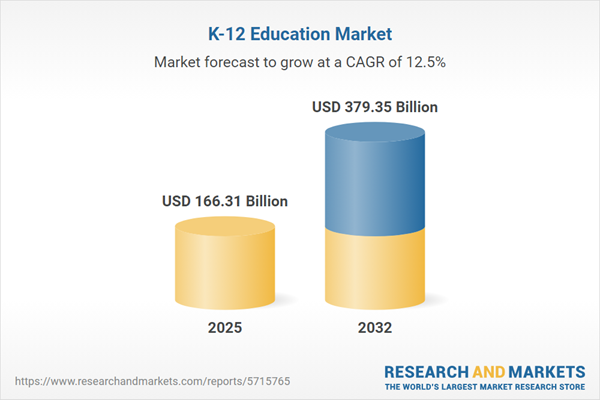Speak directly to the analyst to clarify any post sales queries you may have.
The K-12 education market is undergoing significant transformation as digitalization accelerates and educational institutions navigate evolving regulatory and pedagogical landscapes. Senior executives are challenged to build strategies that deliver operational efficiency, innovation, and student success in a dynamic environment.
K-12 Education Market Snapshot
The global K-12 education market stands at USD 147.42 billion, with projected growth to USD 166.31 billion by 2025 and USD 379.35 billion by 2032, reflecting a 12.54% CAGR. This strong expansion is fueled by widespread investment in digital learning platforms, adaptive instructional technologies, and diverse delivery formats. As global school systems modernize, student engagement and flexible learning remain top priorities, shaping purchasing and strategic decisions. Senior leaders are responding to competitive market pressures by forging strategic alliances and seeking robust partnerships to meet the complex requirements of various regions and educational settings.
K-12 Education Market Scope & Segmentation
This report provides a decision framework for senior leaders to navigate the evolving K-12 education market. Detailed segmentation allows for targeted resource allocation and planning by clarifying the scope of products, technologies, and regional factors influencing growth. Key segment categories include:
- Product Type: Instructional content platforms, immersive hardware solutions, and integrated software, including both cloud-based and on-premises systems for teaching and administration.
- Education Level: Segmentation by elementary, middle, and high school institutions, each presenting distinct instructional and operational challenges.
- School Type: Analysis of procurement and compliance methodologies across charter, public, private, for-profit, and nonprofit educational organizations.
- Delivery Mode: Evaluation of blended, hybrid, synchronous online, asynchronous digital, and self-paced models designed to support varying student learning preferences.
- Geographical Regions: Comparative analysis across the Americas, Europe, Middle East and Africa, and Asia-Pacific, emphasizing region-specific regulatory environments and adoption rates for educational technology.
- Companies Covered: Benchmarking of market leaders such as Pearson plc, McGraw Hill LLC, Houghton Mifflin Harcourt Company, Cengage Learning Holdings II, Scholastic Corporation, Stride, Inc., PowerSchool Group LLC, Blackboard Inc., Discovery Education, and Renaissance Learning, Inc.
Understanding these segments assists leaders in tailoring investments to match local market realities. Insights include how varied regional needs and the adoption pace of cloud solutions, adaptive learning, and blended classrooms call for localized technology strategies at each educational level.
K-12 Education Market: Key Takeaways
- Edtech innovation streamlines administrative operations and bolsters interactions between educators and students, promoting more engaging and impactful learning environments.
- Flexible instructional models, including hybrid and blended formats, support broader student access and adaptability, directly addressing diverse learner needs and educational contexts.
- Modernizing procurement practices and talent management enables education providers to stay responsive to evolving demands from stakeholders and maintain organizational agility amid ongoing market change.
- Regulatory shifts affect technology adoption, procurement, and compliance processes, requiring robust frameworks to ensure the long-term viability and relevance of education institutions.
- Regional differences lead to distinctive approaches in adopting digital classrooms, with Asia-Pacific and the Americas focusing on advanced digital transformation, while EMEA tailors strategies to comply with nuanced local policy considerations.
- Collaboration among technology providers underpins the effective rollout of new pedagogical models and supports a cohesive approach to digital transformation within K-12 institutions.
Tariff Impact: Adapting Procurement and Logistics
Fluctuating global tariffs shape cost structures and disrupt supply chain stability for K-12 education providers. To manage these uncertainties, institutions diversify supplier relationships and use scenario-based logistics planning. This supports financial risk containment and provides flexibility in procurement strategies amidst complex international trade dynamics.
Methodology & Data Sources
This report integrates direct interviews with K-12 district leaders and systematic analysis of academic research, regulatory documents, and validations from industry associations. The methodology ensures that findings are evidence-based, relevant, and actionable for executive decision-making.
Why This Report Matters
- Empowers senior leaders to monitor K-12 education technology trends, refine procurement strategy, and benchmark practices against competitors for continuous improvement.
- Delivers actionable intelligence to assess risk exposure and build resilience in provider networks and supply chain operations.
- Equips organizations to proactively address market and regulatory fluctuations, enhancing long-term planning and institutional sustainability.
Conclusion: Leading Through Market Transformation
Senior executives who champion digital innovation and foster strategic collaboration will position their organizations to excel through ongoing sector transformation, achieving superior learning outcomes and operational success.
Additional Product Information:
- Purchase of this report includes 1 year online access with quarterly updates.
- This report can be updated on request. Please contact our Customer Experience team using the Ask a Question widget on our website.
Table of Contents
3. Executive Summary
4. Market Overview
7. Cumulative Impact of Artificial Intelligence 2025
Companies Mentioned
The companies profiled in this K-12 Education market report include:- Pearson plc
- McGraw Hill LLC
- Houghton Mifflin Harcourt Company
- Cengage Learning Holdings II, Inc.
- Scholastic Corporation
- Stride, Inc.
- PowerSchool Group LLC
- Blackboard Inc.
- Discovery Education, Inc.
- Renaissance Learning, Inc.
Table Information
| Report Attribute | Details |
|---|---|
| No. of Pages | 184 |
| Published | October 2025 |
| Forecast Period | 2025 - 2032 |
| Estimated Market Value ( USD | $ 166.31 Billion |
| Forecasted Market Value ( USD | $ 379.35 Billion |
| Compound Annual Growth Rate | 12.5% |
| Regions Covered | Global |
| No. of Companies Mentioned | 11 |









